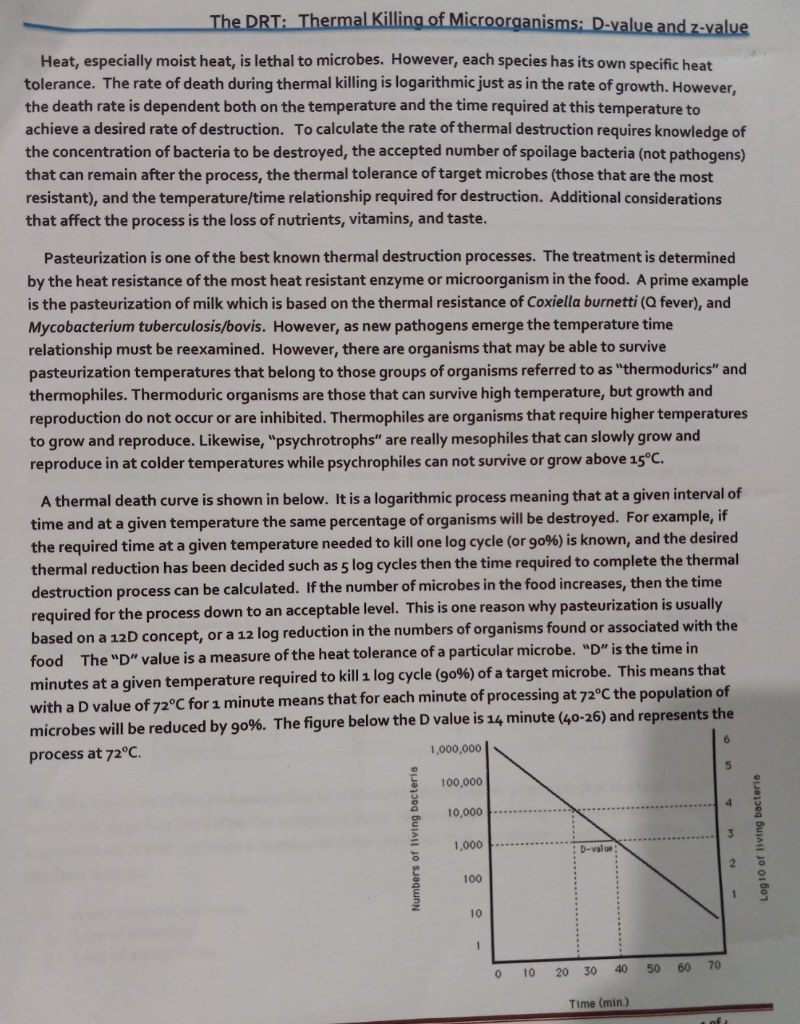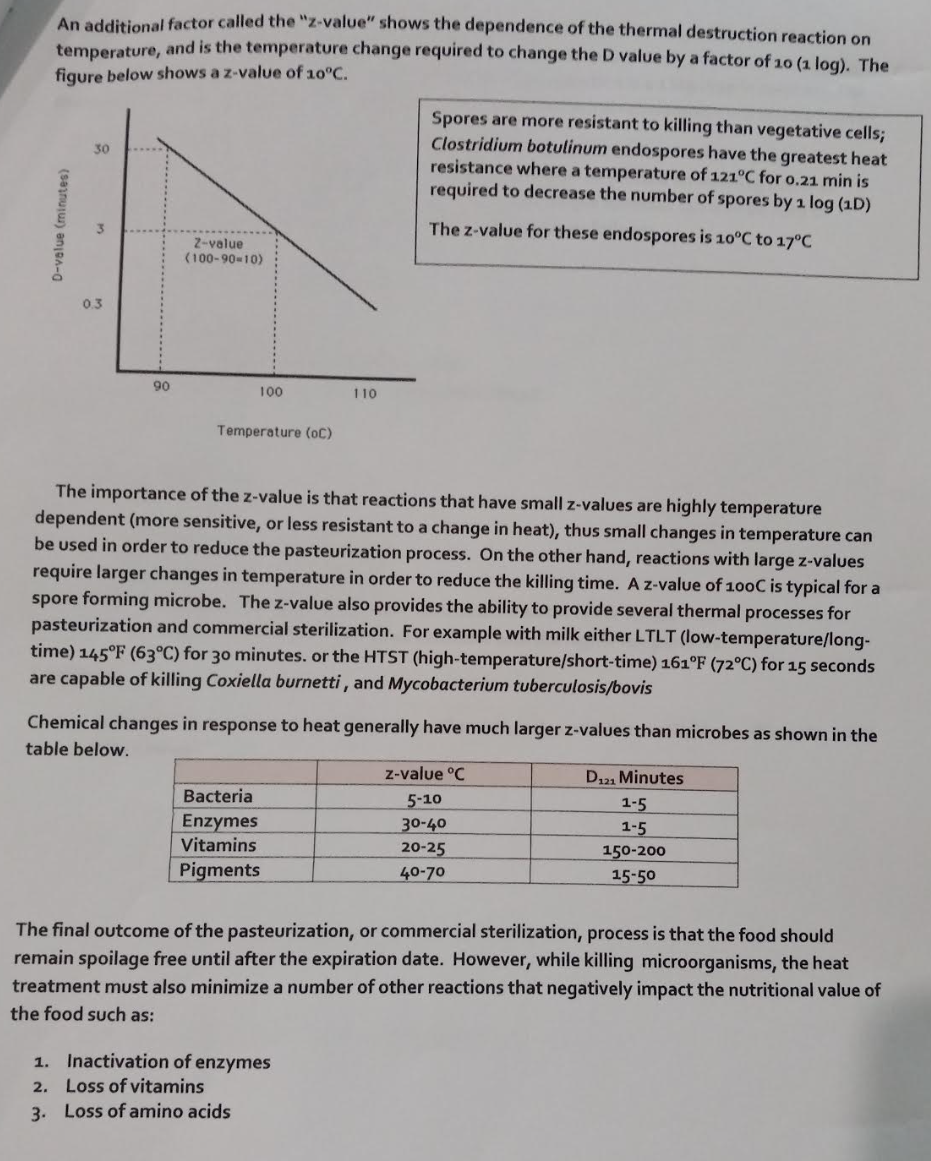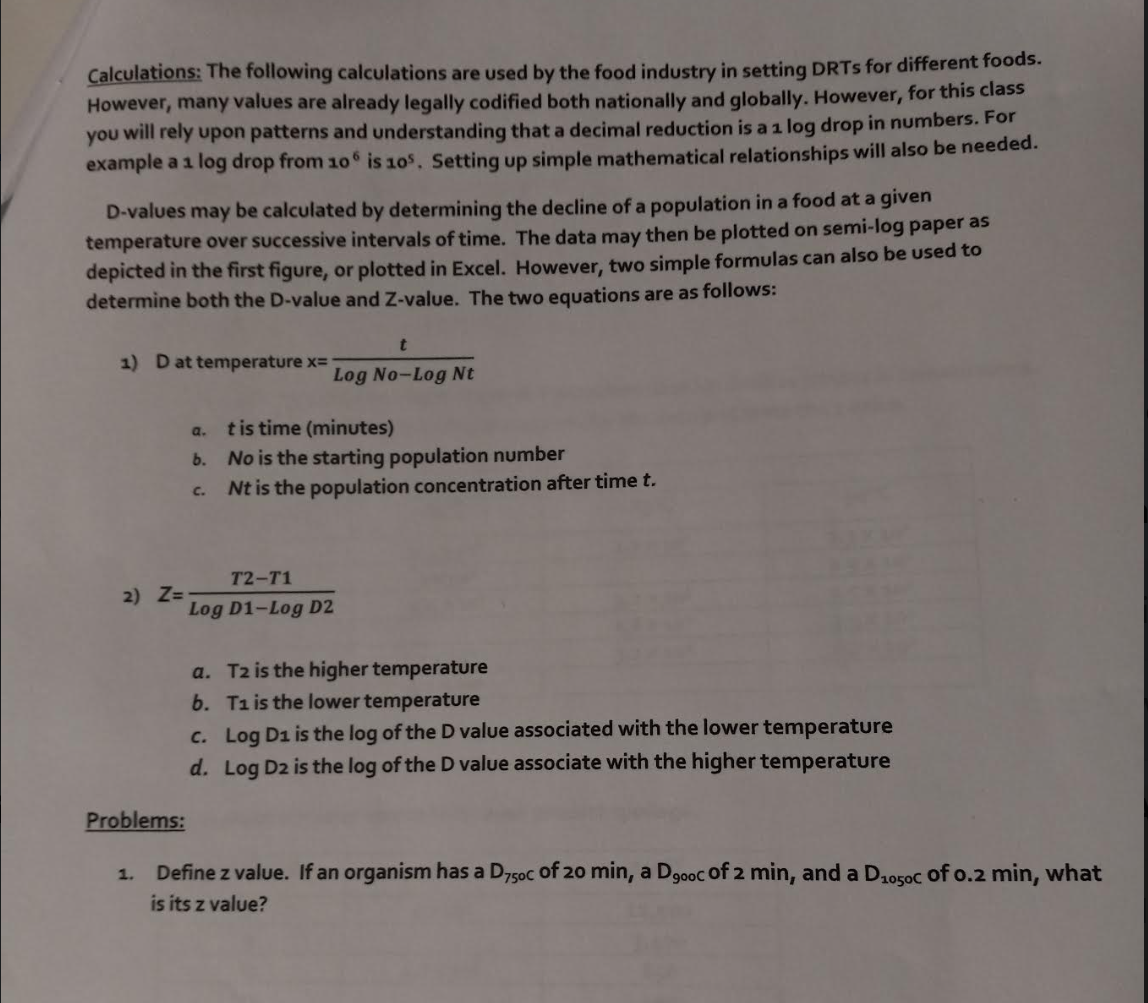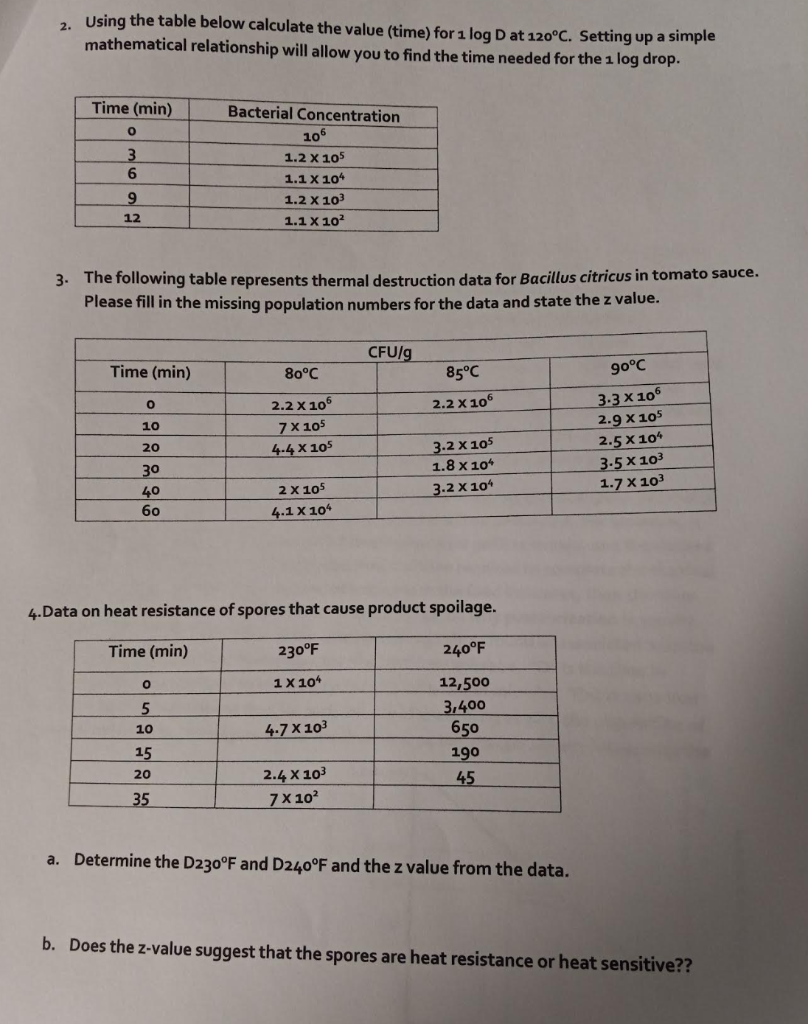Please help with these questions #1, #2, #3. #4a and #4b and provide the calculations for each question. Thank you in advance. This is the only information I was given please help.




The DRT: Thermal Killing of Microorganisms; D-value and z-value Heat, especially moist heat, is lethal to microbes. However, each species has its own specific heat tolerance. The rate of death during thermal killing is logarithmic just as in the rate of growth. However, the death rate is dependent both on the temperature and the time required at this temperature to achieve a desired rate of destruction. To calculate the rate of thermal destruction requires knowledge of the concentration of bacteria to be destroyed, the accepted number of spoilage bacteria (not pathogens) that can remain after the process, the thermal tolerance of target microbes (those that are the most resistant), and the temperature/time relationship required for destruction. Additional considerations that affect the process is the loss of nutrients, vitamins, and taste. Pasteurization is one of the best known thermal destruction processes. The treatment is determined by the heat resistance of the most heat resistant enzyme or microorganism in the food. A prime example is the pasteurization of milk which is based on the thermal resistance of Coxiella burnetti ( Q fever), and Mycobacterium tuberculosis/bovis. However, as new pathogens emerge the temperature time relationship must be reexamined. However, there are organisms that may be able to survive pasteurization temperatures that belong to those groups of organisms referred to as "thermodurics" and thermophiles. Thermoduric organisms are those that can survive high temperature, but growth and reproduction do not occur or are inhibited. Thermophiles are organisms that require higher temperatures to grow and reproduce. Likewise, "psychrotrophs" are really mesophiles that can slowly grow and reproduce in at colder temperatures while psychrophiles can not survive or grow above 15C. A thermal death curve is shown in below. It is a logarithmic process meaning that at a given interval of time and at a given temperature the same percentage of organisms will be destroyed. For example, if the required time at a given temperature needed to kill one log cycle (or 90% ) is known, and the desired thermal reduction has been decided such as 5 log cycles then the time required to complete the thermal destruction process can be calculated. If the number of microbes in the food increases, then the time required for the process down to an acceptable level. This is one reason why pasteurization is usually based on a 12D concept, or a 12 log reduction in the numbers of organisms found or associated with the food The " D " value is a measure of the heat tolerance of a particular microbe. " D " is the time in minutes at a given temperature required to kill 1 log cycle (90%) of a target microbe. This means that with a D value of 72C for 1 minute means that for each minute of processing at 72C the population of microbes will be reduced by 90%. The figure below the D value is 14 minute (4026) and represents the process at 72C. An additional factor called the " z-value" shows the dependence of the thermal destruction reaction on temperature, and is the temperature change required to change the D value by a factor of 10(1log). The figure below shows a z-value of 10C. Spores are more resistant to killing than vegetative cells; Clostridium botulinum endospores have the greatest heat resistance where a temperature of 121C for 0.21min is required to decrease the number of spores by 1log(1D) The z-value for these endospores is 10C to 17C The importance of the z-value is that reactions that have small z-values are highly temperature dependent (more sensitive, or less resistant to a change in heat), thus small changes in temperature can be used in order to reduce the pasteurization process. On the other hand, reactions with large z-values require larger changes in temperature in order to reduce the killing time. A z-value of 100C is typical for a spore forming microbe. The z-value also provides the ability to provide several thermal processes for pasteurization and commercial sterilization. For example with milk either LTLT (low-temperature/longtime) 145F(63C) for 30 minutes. or the HTST (high-temperature/short-time) 161F(72C) for 15 seconds are capable of killing Coxiella burnetti, and Mycobacterium tuberculosis/bovis Chemical changes in response to heat generally have much larger z-values than microbes as shown in the table below. The final outcome of the pasteurization, or commercial sterilization, process is that the food should remain spoilage free until after the expiration date. However, while killing microorganisms, the heat treatment must also minimize a number of other reactions that negatively impact the nutritional value of the food such as: 1. Inactivation of enzymes 2. Loss of vitamins 3. Loss of amino acids Calculations: The following calculations are used by the food industry in setting DRTs for different foods. However, many values are already legally codified both nationally and globally. However, for this class you will rely upon patterns and understanding that a decimal reduction is a 1 log drop in numbers. For example a 1 log drop from 106 is 105, Setting up simple mathematical relationships will also be needed. D-values may be calculated by determining the decline of a population in a food at a given temperature over successive intervals of time. The data may then be plotted on semi-log paper as depicted in the first figure, or plotted in Excel. However, two simple formulas can also be used to determine both the D-value and Z-value. The two equations are as follows: 1) D at temperature x=logNologNtt a. t is time (minutes) b. No is the starting population number c. Nt is the population concentration after time t. 2) Z=logD1logD2T2T1 a. T2 is the higher temperature b. T1 is the lower temperature c. Log D1 is the log of the D value associated with the lower temperature d. Log D2 is the log of the D value associate with the higher temperature Problems: 1. Define z value. If an organism has a D750c of 20min, a D900c of 2min, and a D1050c of 0.2min, what is its z value? 2. Using the table below calculate the value (time) for 1logD at 120C. Setting up a simple mathematical relationship will allow you to find the time needed for the 1log drop. 3. The following table represents thermal destruction data for Bacillus citricus in tomato sauce. Please fill in the missing population numbers for the data and state the z value. 4. Data on heat resistance of spores that cause product spoilage. a. Determine the D230F and D240F and the z value from the data. b. Does the z-value suggest that the spores are heat resistance or heat sensitive










